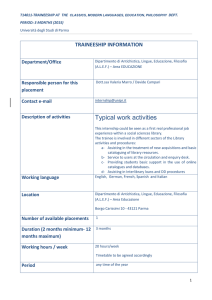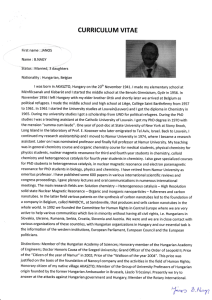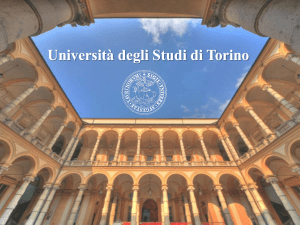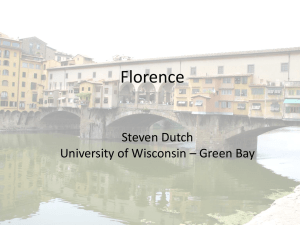Professor Sir David Watson: What is the University For?
advertisement
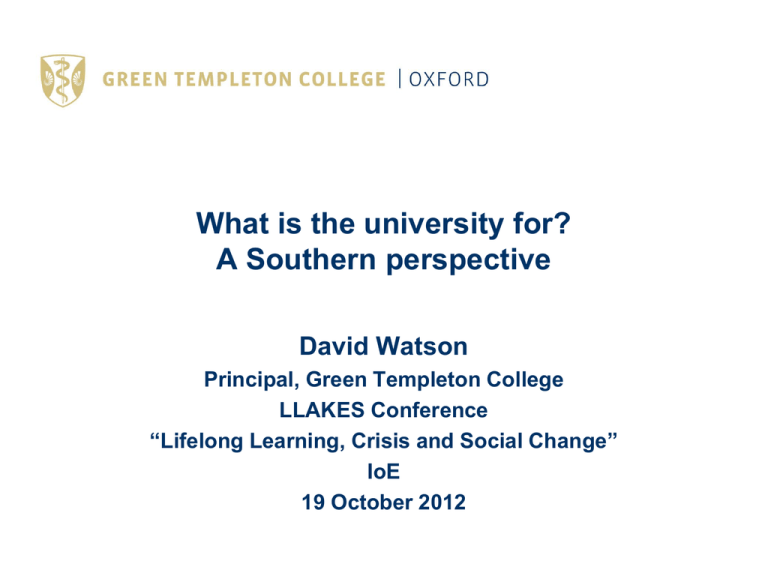
What is the university for? A Southern perspective David Watson Principal, Green Templeton College LLAKES Conference “Lifelong Learning, Crisis and Social Change” IoE 19 October 2012 Outline • Some theory - forms of engagement • Some history - communities and the formation of universities • Competing narratives • A global perspective and a “southern narrative” What Stefan doesn’t see • • • • • • Expansion and democratisation Scholarly peaks in surprising places Achievement by non-standard students Lifelong learning The international campus Adaptation to the internet David Watson (2012): What are universities for?, London Review of Education, 10:2, 237-239 http://dx.doi.org/10.1080/14748460.2012.691289 “First order engagement” • • • • “being there” graduates civil society treasures “Second order engagement” • contracts • partnerships • “stakeholders” “Third order engagement” • academic citizenship • membership • strategic choices University “foundations” in historical perspective • Late medieval specialist communities • Regional and national institutions serving post-industrial society • Public “systems” of HE • Curriculum and institutional innovation • The “dual sector” • “For-profit” Know your history UK USA • From seminaries to the Ivy •Oxford and Cambridge League •Victorian & Edwardian civics • Land grant •The “public sector” • State systems •Institutional innovations (e.g. OU) • Institutional innovations •HE in FE • Community colleges University history: grand narratives • • • • • Liberal emancipation Professional formation The research engine Business services National pride The “civic and community” engagement narrative • Civic duty • Curriculum • Research, development and “business services” • Public sector partnership • Shared and open access facilities • Environmental impact Talloires network: self-assessment • • • • • • An international association of institutions committed to strengthening the civic roles and social responsibilities of higher education Initial 29 signatories from 23 countries of the Talloires declaration (September 2005) The Network “envisions universities around the world as a vibrant and dynamic force in their societies, incorporating civic engagement and community service into their research and teaching mission.” As at April 2012 247 members from: Africa (34); East Asia and Pacific (32); Europe and Central Asia (42); Latin American and Caribbean (37); Middle East and North Africa (13); North America (59); and South Asia (19). (Gaps are China, Japan and Nordic countries.) See: www.tufts.edu/talloiresnetwork/ Initial self-assessments based on Watson, D. (2007) Managing Civic and Community Engagement Maidenhead: Open University Press The Engaged University International Perspectives on Civic Engagement By David Watson, Robert Hollister, Susan E. Stroud, Elizabeth Babcock Published April 6th 2011 by Routledge What’s the jurisdiction? • Governance (strategic direction, appointment of leaders, accountability) • Funding (direct and indirect controls, e.g. fees) • Operational conditions (subjects and levels of provision, conditions of employment, procurement etc.) The cases: the North • Georgetown University (USA), founded 1789, private, 14,000 students • Portland State (USA), founded 1946, public, 24,000 students • University of Winchester (UK), founded 1969, 5,500 students The cases: the South •Charles Darwin University (Australia), founded 2003, public, 4,300 students •University of Western Sydney (Australia), founded 1990, public, 36,000 students •SNDT Women’s University of Mumbai (India), founded 1916, public, 70,000 students •Al-Quds University (Jerusalem), public and international, founded 1995, 8,000 students •Universiti KebangsaMalaysia,public, founded 1970, 24,000 students •Tecnológico de Monterrey (Mexico), private, founded 1943, 91,000 students •Aga Khan University (Pakistan), private, founded 1983, 2,000 students •Universidad Señor di Sipán (Peru), private, founded 1999, 7,500 students •Notre Dame of Marbel University (Philippines), private, founded 1955, 6,000 students •Cape Peninsula University of Technology (South Africa), public, founded 2003, 29,000 students •Afhad University for Women (Sudan), private, founded 1966, 5,400 students •University of Dar-es-Salaam (Tanzania), public, founded 1970, 14,600 students •Universidad Metropolitana en Caracas (Venezuela), public, founded 1944, 56,000 students The cases: “transitional” • University of Melbourne (Australia), public, founded 1853, 33,600 students • University of Haifa (Israel), public, founded 1972, 16,000 students • Open University (UK), public, founded 1969, 180,000 students • Petro Mohyla Black Sea National University (Ukraine), founded 1840, public, 5,000 students University-community engagement: the “northern consensus” • • • • • “Being there” Character and democratic instincts Service-learning and volunteering Public support Knowledge transfer “Southern Theory” • “Social science can only have one, universal, body of social theory, the one created in the global North” (Connell, 2007: ix). • The “new configurations of knowledge that result when Southern theory is everywhere respected, and differently formed theories speak together” (Connell, 2007: xiv). “Globalization from below.” • “It means stepping back from those obsessions and abstractions that constitute our own professional practice to seriously consider the problems of the global everyday.” (Appadurai, 2000: 17-18). • “In the public spheres of many societies there is concern that policy debates occurring around world trade, copyright, environment, science and technology set the stage for life-and-death decisions for ordinary farmers, vendors, slum-dwellers, merchants and urban populations. And running through these debates is the sense that social exclusion is ever more tied to epistemic exclusion and concern that the discourse of expertise that are setting the rules for global transactions, even in the most progressive parts of the international system have left ordinary people outside and behind. (Appadurai, 2000: 2). The view from the South Universities in the “global everyday” • • • • • • • External national power and internal control Social, political and economic circumstances Professional/vocational training “Translational” research Aid Academic freedom (and corruption) A global header tank (e.g. brain circulation, IPR) University-community engagement: a “southern narrative”? (1) – relative lack of a “comfort zone;” – drive for “transformation” or “solidarity;” – priority of “development” (or social returns) over “character” (or individual returns); and of “national cohesion” over personal enrichment; – strong focus on human capital, and “employment” over “employability;” – “necessity trumps choice,” and investment in HE is seen as more than a consumer good; University-community engagement: a “southern narrative”? (2) – use of private bodies for public purposes; – use of international partnerships for assistance not “positioning;” – fewer hang-ups about the instrumentality of the “vocational curriculum;” – acceptance that religion and science should work in harmony; – a very practical world of “Mode 2” engagement, alongside Mode 2 research and teaching; – a sense of societal pull over institutional push. Discussion
